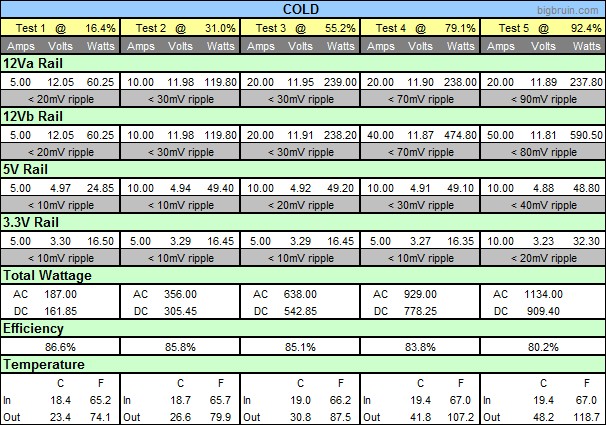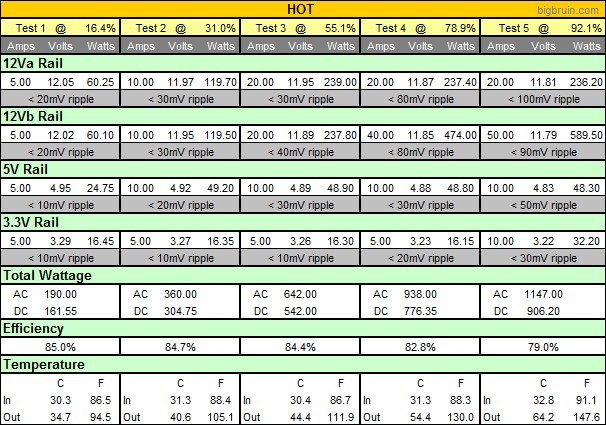Testing (continued):
The plan is to test the power supply at a few steps between minimum and maximum power, and record the results. This will be done with the power supply drawing in ambient temperature air (which was approximately 18C), as well as with the heat source being used to maintain an inlet temperature of about 30C (temperature was regulated by varying the proximity to the heat source). The specifications details a MTBF of 100,000 hours at 40C, and that it is rated for 1000W continuous service at 40C. While this is much better than the 25C seen with the recently reviewed 850W Ultra Products unit, it is likely that a unit like this would run over 40C while maintaining anything close to a continuous 1000W. We won't have long term data to present, but it will be interesting to see how hot it might get.
This paragraph will map the basics found in the charts below. The heading "COLD" in blue and "HOT" in orange indicate whether the test was done at ambient temperature or with the additional heat at the inlet. On the next line we see a yellow background with the test number and a percentage in each box. The steps chosen do not correspond to a typical percentage you might test at (ie, 25% or 50%), but were rather chosen to be nice round Amperage values to dial in to the loaders that took into consideration the limits of the test equipment, the individual rail ratings, and the combined rail ratings. The percentage value is that of the total load calculated by dividing the total DC Wattage by 984 (the total combined power on the 12V, 5V, and 3.3V rails - which is also the total combined power of just the 12V rails alone). The next area on the chart details the electrical data for the three main rails as they were divided up among the four loaders. As mentioned, there are four 12V rails each rated for 36A each, but with the test equipment on hand some had to be combined. From information I have gathered from other reviews of this PSU (specifically at
HardOCP and
JonnyGuru), 12V rail number three has some 'interesting' performance characteristics so I decided to isolate that rail for testing on a 300W loader. The other three 12V rails were all combined to be tested on one 750W loader. In gray below each entry for Amps, Volts, and Watts we see a ripple value as described previously. Below the entries for all three Voltage rails we see a Total Wattage field. AC power was read from the AC power monitor, while DC power was calculated by summing the values from the three rails during that test. Dividing this DC power value by the AC power value gives us the efficiency (shown in the next field down), while dividing this DC power value by 984 is where we get the percentage shown at the top of each column. In the final field we see the inlet and outlet temperatures (logged in F, and converted to C).

For the COLD test we see that the unit was tested up to 909W, or 92.4% of its capacity. The regulation on all three rails was within specification, with the 12V rails ranging from 12.05 to 11.81V, the 5V rail ranging from 4.97V to 4.88V, and the 3.3V rail ranging from 3.30V to 3.23V. Allowable ripple on the 5V and 3.3V rails is 50mV, while it is 120mV on the 12V rail. Other reviews show that the ripple on this unit can be a problem, with some sites reporting that it goes out of specification under a heavy load. While I was able to detail higher ripple values than you would like to see, I did not get results that were out of specification. I see this as more motivation to replace the USB data logger with something offering better features. It also makes me wonder about the effect of combining 12V rails on to one loader, as that could obviously have an effect on readings. As far as efficiency goes, the unit stayed above 80% during all tests, and was almost good enough for 80 Plus Bronze (which requires an efficiency of 82% at a 20% and a 100% load, and an efficiency of 85% at a 50% load).

From the HOT test we see the same basic trend echoed from the COLD test. The regulation is acceptable, although the range of voltages does increase at higher loads. The ripple is still high, and that 12V3 rail gets up near the 100mV mark at the highest load. Efficiency drops slightly across the board, and under a high load it drops below 80%. While my testing methodology doesn't follow the standard, the results are in the ballpark and I might call it acceptable with a plus/minus tolerance of a few percentage points.
One other thing we see with the HOT test is that things can get hot. It is easy to expect the unit to run above 40C at 1000W (or much less), so the MTBF could be expected to be shorter than 100,000 hours under such conditions. The cooling fan never got loud, which is definitely a nice thing, but a little extra noise would be acceptable to me if it meant keeping the internal components cooler.